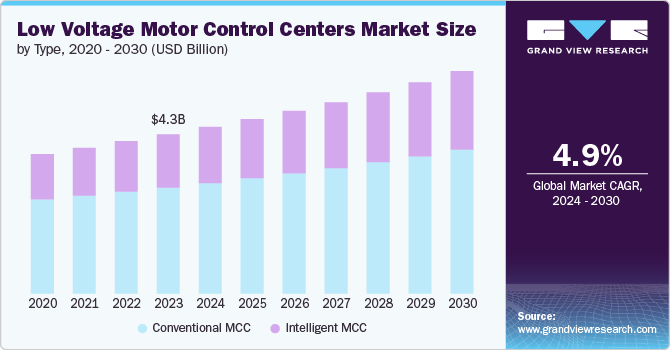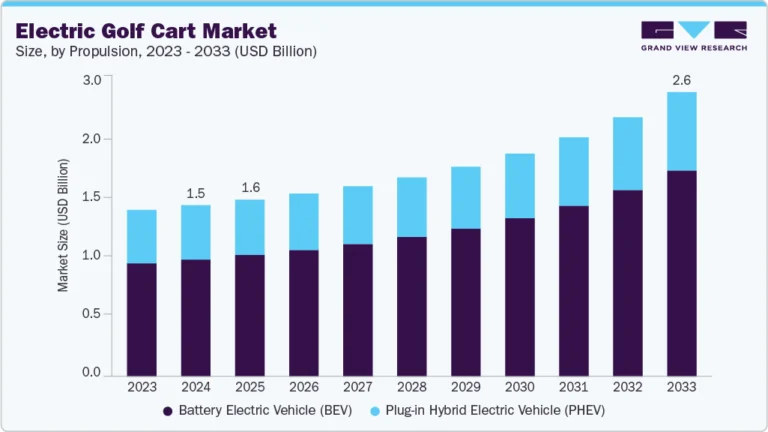Low Voltage Motor Control Centers Market Size, Share & Trends Analysis growing at a CAGR of 4.9% from 2024 to 2030

The global low voltage motor control centers market size was estimated at USD 4.28 billion in 2023 and is projected to reach USD 5.97 billion by 2030, growing at a CAGR of 4.9% from 2024 to 2030. Low-voltage motor control centers (MCCs) are factory-assembled enclosures that house and manage the starting, stopping, and protection of individual electric motors.
Key Market Trends & Insights
- The low voltage motor control centers market in North America is expected to witness at a steady CAGR from 2024 to 2030.
- Asia Pacific dominated the low voltage motor control centers market with the revenue share of 40.4% in 2023.
- Based on type, the conventional MCC segment led the market with the largest revenue share of 66.6% in 2023.
- Based on component, the busbars segment led the market with the largest revenue share of 23.3% in 2023.
- Based on end use, the industrial segment led the market with the largest revenue share of 71.9% in 2023.
Market Size & Forecast
- 2023 Market Size: USD 4.28 Billion
- 2030 Projected Market Size: USD 5.97 Billion
- CAGR (2024-2030): 4.9%
- Asia Pacific: Largest market in 2023
Request a free sample copy or view report summary: https://www.grandviewresearch.com/industry-analysis/low-voltage-motor-control-centers-market-report/request/rs1
They typically cater to low-voltage (up to 600V) three-phase AC motors, prevalent in various industrial and commercial applications. MCCs integrate various components like motor starters, circuit breakers, fuses, meters, and control devices within a single, organized structure. This centralized control facilitates efficient power distribution, motor operation monitoring, and safety measures within a facility.
The market is on track for steady growth. Fueled by the rise of industrial automation, MCCs provide a centralized and reliable solution for managing electric motors in sectors like manufacturing, oil & gas, and food & beverage. In addition, the growing focus on energy efficiency aligns perfectly with features like variable frequency drives (VFDs) that modern MCCs offer, optimizing motor speed and power consumption. Finally, rapid urbanization and infrastructure development worldwide are driving the demand for reliable power distribution solutions, including MCCs, for various commercial and public buildings. These factors combined paint a promising picture for the future of the low-voltage motor control center market.
Stringent regulations play a crucial role in ensuring the safety and efficacy of low-voltage motor control centers. To guarantee safe and efficient operation, MCCs must adhere to a multitude of national and international safety and performance standards. Prominent examples include the National Electrical Code (NEC) established in the United States, which sets the baseline for electrical safety. In addition, the International Electro technical Commission (IEC) 60439 provides international guidelines for the construction and testing of low-voltage switchgear and control gear assemblies. Furthermore, Underwriters Laboratories (UL), a non-profit organization in North America, offers product safety certifications. By complying with these regulations, proper design, construction, and maintenance practices for MCCs are ensured, minimizing electrical hazards and fostering a safe operational environment.
The market is experiencing significant growth fueled by several key factors. A heightened focus on safety is propelling the adoption of modern MCCs equipped with features like arc flash protection and ground fault detection. This emphasis on operator and equipment well-being is a major driver. In addition, the growing preference for modular designs by manufacturers caters to the evolving needs of diverse industrial applications. These modular MCCs offer greater flexibility for customization, expansion, and maintenance. Furthermore, advanced MCCs can integrate with Building Management Systems (BMS), enabling centralized monitoring and control of facility motors. This integration translates to optimized energy consumption and improved operational efficiency. These drivers, coupled with the increasing focus on industrial automation and energy conservation, are creating a highly favorable market landscape for low-voltage motor control centers.
Despite a promising future, the low-voltage motor control center market grapples with several challenges. A significant hurdle lies in the shortage of skilled electrical personnel. Proper installation, operation, and maintenance of MCCs necessitate qualified labor, and deficiencies in this area can hinder market growth, particularly in some regions. In addition, the initial investment cost of MCCs presents a barrier for budget-conscious facilities. Compared to basic motor starters, MCCs carry a higher price tag due to their complex design and functionalities. Finally, the rapid evolution of motor control technology and automation can render older MCC models obsolete faster, necessitating frequent upgrades, which can strain budgets and resources. These challenges demand innovative solutions from manufacturers and service providers to ensure the continued success of the global market.
The market presents exciting opportunities for manufacturers and service providers. A key focus should be on developing “smart MCCs” equipped with features like internet connectivity, remote monitoring, and predictive maintenance. These capabilities align perfectly with the growing demand for smart industrial solutions. In addition, the burgeoning industrial sectors in developing nations represent a vast potential market for MCCs, creating a demand for cost-effective and reliable solutions. Finally, providing comprehensive aftermarket services such as maintenance, repair, and modernization for existing MCC installations can be a lucrative revenue stream. By addressing the current challenges and capitalizing on these emerging opportunities, the low-voltage motor control center market is well positioned for sustained growth and innovation.






